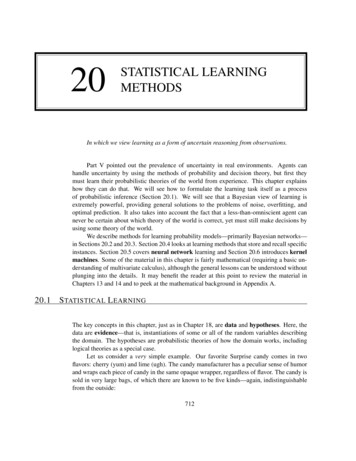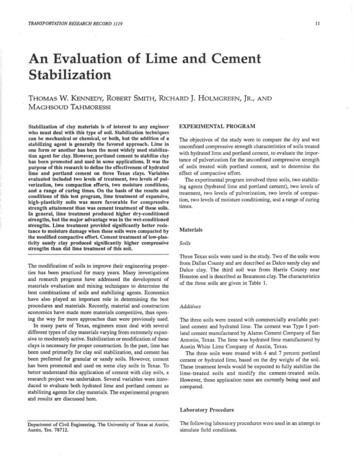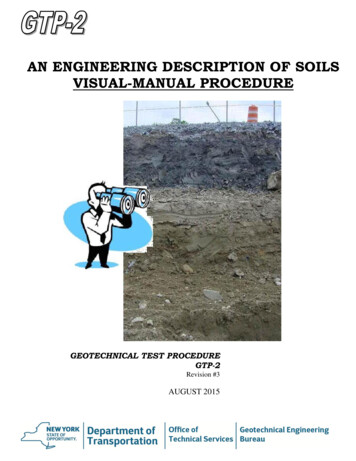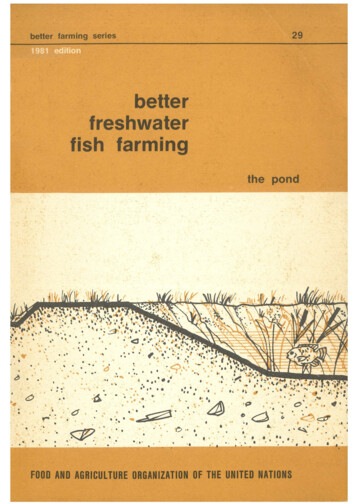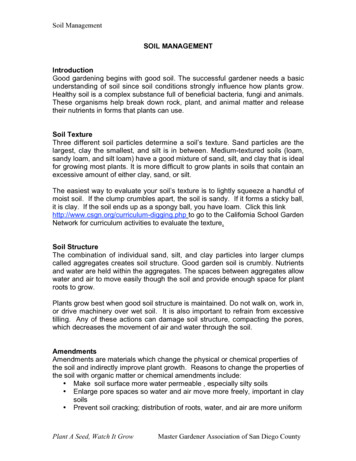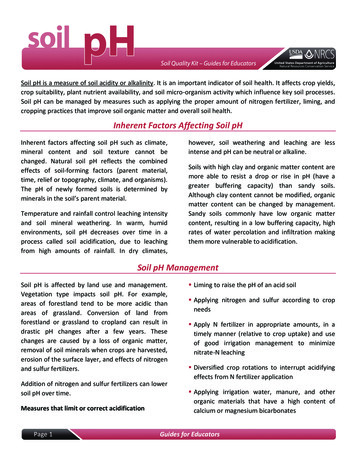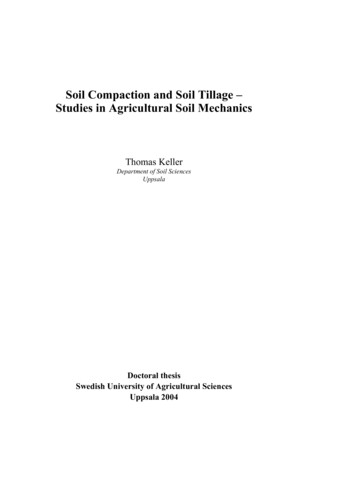
Transcription
LIME-TREATED SOILCONSTRUCTION MANUALLIME STABILIZATION & LIME MODIFICATIONPublished byJanuary 2004Bulletin 326
ForewordThis manual is written for construction contractors developing project bids, planningjobs, and conducting construction activities; for engineers preparing lime stabilizationconstruction specifications; for project inspectors; and for civil engineering students.This publication was originally written by the American Road Builders AssociationSubcommittee on Lime Stabilization and published in 1959 as ARBA TechnicalBulletin 243. The National Lime Association assumed publication rights in 1965.This eleventh edition was significantly revised in 2003. About 90,000 copies ofprevious editions of this manual have been distributed.Disclaimer:This document is for general guidance and reference purposes only. It is intended for use byprofessional personnel competent to evaluate the significance and limitations of theinformation provided and who will accept full responsibility for the application of thisinformation. This document does not supersede or modify any legal requirements, and it is nota binding standard or specification. No liability of any kind is created or assumed by theNational Lime Association or its members arising out of any use of it. The National LimeAssociation does not intend to infringe on any patent or other intellectual property right orinduce any other party to do so, and thus users of this document are responsible fordetermining whether any method, technique, or technology described herein is protected bypatent or other legal restriction.Page 2
Table of ContentsCHAPTER I: INTRODUCTION . 4What is Lime? . 5Lime Stabilization of Soils . 6Lime Modification & Soil Drying . 7The Chemistry of Lime Treatment . 7Lime-Pozzolan Mixtures for Soils with Low Amounts of Clay . 9CHAPTER II: OVERVIEW AND COMPARISON OF CONSTRUCTION PROCEDURES . 10Construction Overview . 10Advantages and Disadvantages of Different Lime Applications . 10CHAPTER III: DETAILED DESCRIPTION OF CONSTRUCTION STEPS . 12Delivery . 12Subgrade (or Subbase) Stabilization . 141.2.3.4.5.6.7.Scarification and Initial Pulverization. 14Lime Spreading. 16Preliminary Mixing and Watering. 18Mellowing Period. 21Final Mixing and Pulverization. 21Compaction. 22Final Curing . 23Base Stabilization . 24Full Depth Reclamation . 24Aggregate Base Course – Central Mixing. 25Lime for Drying & Modification. 25CHAPTER IV: ADDITIONAL CONSIDERATIONS . 27Maintaining Traffic. 27Need for Wearing Surface . 27Climatic Limitations . 27Freezing Contingencies . 27Early Spring Start . 28Construction Flexibility . 28Rain Not Detrimental. 28Lime Safety Precautions . 28Worker Safety. 28Product Safety. 29First Aid. 29Dry Lime – Bags . 29Bulk Density. 30Use of Other Stabilizers with Lime . 30Base Stabilization . 30Lime-Fly Ash or Lime Kiln Dust Subgrade Construction . 31Sulfates. 32CHAPTER V: NON-HIGHWAY APPLICATIONS . 33Airports. 33Commercial . 34Housing. 34Embankment Stabilization . 35APPENDICES. 37Appendix A:Appendix B:Appendix C:Appendix D:Specifications . 37NLA Soil Stabilization Publications. 38Plasticity Index (PI). 39Charts (converting percent to weight & bag spacing) . 40Page 3
CHAPTER I:INTRODUCTIONThe long-term performance of any construction project depends on the soundness of theunderlying soils. Unstable soils can create significant problems for pavements or structures(Figure 1). With proper design and construction techniques, lime treatment chemicallytransforms unstable soils into usable materials (Figure 2). Indeed, the structural strength of limestabilized soils can be factored into pavement designs.Figure 1: Extreme example of pavement failure from unstable soilsFigure 2: Comparing untreated plastic clay to lime-treated clay after initial mixing and mellowingPage 4
Lime can be used to treat soils to varying degrees, depending upon the objective. The leastamount of treatment is used to dry and temporarily modify soils. Such treatment produces aworking platform for construction or temporary roads. A greater degree of treatment--supportedby testing, design, and proper construction techniques--produces permanent structuralstabilization of soils.Before beginning any construction project, project plans and specifications must be developed.For highway pavements, the design must accommodate expected traffic volumes along withenvironmental, site, and material conditions. All structural designs should be based uponlaboratory tests and mix designs that fit the demands of the particular project and provide themost economical alternative for the planned use. This manual focuses on the subsequentconstruction aspects of treating soils with lime. The testing and design of stabilized soil layers isaddressed elsewhere. For example, see the mix design and testing protocol athttp://www.lime.org/SOIL3.PDF .This manual was originally written for highway pavement applications, and this revised editionmaintains that focus because most lime for soil treatment is used in highway construction.However, the use of lime for soil drying, temporary modification, and permanent stabilization isnot limited to highway construction--see Chapter V for more information.What is Lime?Lime in the form of quicklime (calcium oxide – CaO), hydrated lime (calcium hydroxide –Ca[OH]2), or lime slurry1 can be used to treat soils. Quicklime is manufactured by chemicallytransforming calcium carbonate (limestone – CaCO3) into calcium oxide. Hydrated lime iscreated when quicklime chemically reacts with water. It is hydrated lime that reacts with clayparticles and permanently transforms them into a strong cementitious matrix.Most lime used for soil treatment is “high calcium” lime, which contains no more than 5 percentmagnesium oxide or hydroxide. On some occasions, however, "dolomitic" lime is used.Dolomitic lime contains 35 to 46 percent magnesium oxide or hydroxide. Dolomitic lime canperform well in soil stabilization, although the magnesium fraction reacts more slowly than thecalcium fraction.Sometimes the term “lime” is used to describe agricultural lime which is generally finely groundlimestone, a useful soil amendment but not chemically active enough to lead to soil stabilization.“Lime” is also sometimes used to describe byproducts of the lime manufacturing process (suchas lime kiln dust), which, although they contain some reactive lime, generally have only afraction of the oxide or hydroxide content of the manufactured product. In this manual, “lime”means quicklime, hydrated lime, or hydrated lime slurry.1Lime slurry, a suspension of hydrated lime in water, can be made from either hydrated lime or quicklime.Page 5
Lime Stabilization of SoilsSoil stabilization significantly changes the characteristics of a soil to produce long-termpermanent strength and stability, particularly with respect to the action of water and frost(Figure 3).Figure 3: Lime-stabilized layer (see arrow) bridging an erosion failure illustrates strengthLime, either alone or in combination with other materials, can be used to treat a range of soiltypes. The mineralogical properties of the soils will determine their degree of reactivity withlime and the ultimate strength that the stabilized layers will develop. In general, fine-grainedclay soils (with a minimum of 25 percent passing the #200 sieve (74mm) and a Plasticity Indexgreater than 10) are considered to be good candidates for stabilization. Soils containingsignificant amounts of organic material (greater than about 1 percent) or sulfates (greater than0.3 percent) may require additional lime and/or special construction procedures.Subgrades (or Subbases): Lime can permanently stabilize fine-grained soil employed as asubgrade or subbase to create a layer with structural value in the pavement system. The treatedsoils may be in-place (subgrade) or borrow materials. Subgrade stabilization usually involves inplace “road mixing,” and generally requires adding 3 to 6 percent lime by weight of the dry soil.2Bases: Lime can permanently stabilize submarginal base materials (such as clay-gravel, “dirty”gravels, limestones, caliche) that contain at least 50 percent coarse material retained on a #4screen. Base stabilization is used for new road construction and reconstruction of worn-outroads, and generally requires adding 2 to 4 percent lime by weight of the dry soil. In-situ “roadmixing” is most commonly used for base stabilization, although off-site “central mixing” canalso be used. Lime is also used to improve the properties of soil/aggregate mixtures in “fulldepth recycling.”2Lime percentages should be determined by an engineer using a mix design and test protocol. A chart to convertlime percentages to weight appears in Appendix D.Page 6
Lime Modification & Soil DryingThere are two other important types of lime treatment used in construction operations:First, because quicklime chemically combines with water, it can be used very effectively to drywet soils. Heat from this reaction further dries wet soils. The reaction with water occurs even ifthe soils do not contain significant clay fractions. When clays are present, lime’s chemicalreaction with clays causes further drying. The net effect is that drying occurs quickly, within amatter of hours, enabling the grading contractor to compact the soil much more rapidly than bywaiting for the soil to dry through natural evaporation.“Dry-up” of wet soil at construction sites is one of the widest uses of lime for soil treatment.Lime may be used for one or more of the following: to aid compaction by drying out wet areas;to help bridge across underlying spongy subsoil; to provide a working table for subsequentconstruction; and to condition the soil (make it workable) for further stabilization with Portlandcement or asphalt. Generally, between 1 and 4 percent lime will dry a wet site sufficiently toallow construction activities to proceed.Second, lime treatment can significantly improve soil workability and short-term strength toenable projects to be completed more easily. Examples include treating fine-grained soils orgranular base materials to construct temporary haul roads or other construction platforms.Typically, 1 to 4 percent lime by weight is used for modification, which is generally less than theamount used to permanently stabilize the soil. The changes made to lime-modified soil may ormay not be permanent. The main distinction between modification and stabilization is thatgenerally no structural credit is accorded the lime-modified layer in pavement design. Limemodification works best in clay soils.The Chemistry of Lime Treatment3When lime and water are added to a clay soil, chemical reactions begin to occur almostimmediately.1.3Drying: If quicklime is used, it immediately hydrates (i.e., chemically combineswith water) and releases heat. Soils are dried, because water present in the soilparticipates in this reaction, and because the heat generated can evaporateadditional moisture. The hydrated lime produced by these initial reactions willsubsequently react with clay particles (discussed below). These subsequentreactions will slowly produce additional drying because they reduce the soil’smoisture holding capacity. If hydrated lime or hydrated lime slurry is usedinstead of quicklime, drying occurs only through the chemical changes in the soilthat reduce its capacity to hold water and increase its stability.For a more detailed discussion of the chemistry of stabilization, see Little, Stabilization of Pavement Subgradesand Base Courses with Lime, 1995.Page 7
2.Modification: After initial mixing, the calcium ions (Ca ) from hydrated limemigrate to the surface of the clay particles and displace water and other ions. Thesoil becomes friable and granular, making it easier to work and compact (Figure4). At this stage the Plasticity Index of the soil decreases dramatically, as does itstendency to swell and shrink. The process, which is called “flocculation andagglomeration," generally occurs in a matter of hours.Figure 4: Lime flocculating clay3.Stabilization: When adequate quantities of lime and water are added, the pH ofthe soil quickly increases to above 10.5, which enables the clay particles to breakdown. Determining the amount of lime necessary is part of the design processand is approximated by tests such as the Eades and Grim test (ASTM D6276).Silica and alumina are released and react with calcium from the lime to formcalcium-silicate-hydrates (CSH) and calcium-aluminate-hydrates (CAH). CSHand CAH are cementitious products similar to those formed in Portland cement.They form the matrix that contributes to the strength of lime-stabilized soil layers.As this matrix forms, the soil is transformed from a sandy, granular material to ahard, relatively impermeable layer with significant load bearing capacity. Theprocess begins within hours and can continue for years in a properly designedsystem. The matrix formed is permanent, durable, and significantly impermeable,producing a structural layer that is both strong and flexible.Page 8
Lime-Pozzolan Mixtures for Soils with Low Amounts of ClayLime by itself can react with soils containing as little as 7 percent clay and Plasticity Indices aslow as 10. If the soil is not sufficiently reactive, lime can be combined with an additional sourceof silica and alumina. Such “pozzolans” include fly ash and ground blast furnace slag. Theadditional silica and alumina from the pozzolan react with the lime to form the strongcementitious matrix that characterizes a lime-stabilized layer. Properly proportioned mixtures oflime and pozzolans can modify or stabilize nearly any soil, but are typically used for soils withlow to medium plasticity.Fly ash is the most commonly used pozzolan. It is the finely divided residue that results from thecombustion of pulverized coal in power plant boilers, which is transported from the combustionchamber by exhaust gases.Use of lime kiln dust (LKD) is an increasingly popular alternative. LKD is the finely dividedresidue that results from the combustion of coal and the processing of limestone into lime in alime kiln, and which is removed from kiln exhaust gases. LKD usually contains a significantamount of lime, alumina, and silica--it is in essence a preblended mix of pozzolan and lime.The amount of lime, silica, and alumina in LKD varies, primarily depending on the limestone,fuel, and kiln operations used during the lime manufacturing process.Page 9
CHAPTER II:OVERVIEW AND COMPARISON OF CONSTRUCTION PROCEDURESConstruction OverviewBecause lime can be used to treat soils to varying degrees, the first step in evaluating soiltreatment options is to clearly identify the objective.The construction steps involved in stabilization and modification are similar. Generally,stabilization requires more lime and more thorough processing and job control than modification.Basic steps include scarifying or partially pulverizing soil,spreading lime,adding water and mixing,compacting to maximum practical density, andcuring prior to placing the next layer or wearing course.When central (off-site) mixing is employed instead of road (in-place) mixing in eitherstabilization or modification, only three of the above steps apply: spreading the lime-aggregatewater mixture, compacting, and curing.Advantages and Disadvantages of Different Lime ApplicationsThe type of lime stabilization technique used on a project should be based on multipleconsiderations, such as contractor experience, equipment availability, location of project (rural orurban), and availability of an adequate nearby water source.Some of the advantages and disadvantages of different lime application methods follow:Dry hydrated lime:Advantages: Can be applied more rapidly than slurry. Dry hydrated lime can be used for dryingclay, but it is not as effective as quicklime.Disadvantages: Hydrated lime particles are fine. Thus, dust can be a problem and renders thistype of application generally unsuitable for populated areas.Dry Quicklime:Advantages: Economical because quicklime is a more concentrated form of lime than hydratedlime, containing 20 to 24 percent more “available” lime oxide content. Thus, about 3 percentquicklime is equivalent to 4 percent hydrated lime when conditions allow full hydration of thequicklime with enough moisture. Greater bulk density requires smaller storage facilities. Theconstruction season may be extended because the exothermic reaction caused with water andquicklime can warm the soil. Dry quicklime is excellent for drying wet soils. Larger particlesizes can reduce dust generation.Page 10
Disadvantages: Quicklime requires 32 percent of its weight in water to convert to hydrated limeand there can be significant additional evaporation loss due to the heat of hydration. Care mustbe taken with the use of quicklime to ensure adequate water addition, mellowing, and mixing.These greater water requirements may pose a logistics or cost problem in remote areas without anearby water source. Quicklime may require more mixing than dry hydrated lime or lime slurriesbecause the larger quicklime particles must first react with water to form hydrated lime and thenbe thoroughly mixed with the soil.Slurry Lime:Advantages: Dust free application. Easier to achieve even distribution. Spreading and sprinklingapplications are combined. Less additional water is required for final mixing.Disadvantages: Slower application rates. Higher costs due to extra equipment requirements.May not be practical in very wet soils. Not practical for drying applications.Page 11
CHAPTER III:DETAILED DESCRIPTION OF CONSTRUCTION STEPSThe following construction recommendations apply to the use of hydrated lime and quicklime inthe stabilization or modification of subgrade (subbase) and base courses and are intended as ageneral guide for contractors, inspectors, and specification writers. Quality assurance/qualitycontrol considerations are presented throughout the chapter.DeliveryDry LimeDry quicklime or hydrated lime is usually delivered in self-unloading transport trucks(Figure 5). Commonly, each load of dry lime delivered to a jobsite carries a weigh ticketcertifying the amount of lime on board. In addition, some agencies require certification of thechemical characteristics of the lime delivered.Figure 5: Example of tanker trucks typically used for dry lime deliveryQuicklime is occasionally delivered to jobsites in dump trucks. Tightly-fitting tarpaulin coversare required for dump trucks to prevent dust loss during transit.SlurrySlurry lime can be produced from quicklime or hydrated lime. It can be delivered from a centralmix plant or produced on site. Slurry preparation facilities should be approved by the projectengineer. Regardless of location, slurry created from quicklime is hot because the chemicalreaction between quicklime and water is exothermic. Slurries created by mixing hydrated limeand water are not hot.Slurry may be prepared in a mixing tank, with agitation for mixing lime and water provided byintegral paddles, compressed air, and/or recirculating pumps. Portable jobsite slaker tankstypically handle 20 to 25 tons of quicklime at a time (Figure 6).Page 12
Figure 6: Portable lime slaker tanks for preparing lime slurry on-siteA second method of slurry production, which eliminates batching tanks, involves the use of acompact jet slurry-mixer (Figure 7). Water at 70 psi pressure and hydrated lime are chargedcontinuously in a 65:35 (weight) ratio into the jet mixing bowl, where slurry is producedinstantaneously. The slurry is pumped directly into trucks for spreading on the construction site.The mixer and auxiliary equipment can be mounted on a small trailer and transported to the jobreadily, giving great flexibility to the operation.In the third type of slurry set-up, measured amounts of water and lime are charged separatelyinto the tank truck, with the slurry being mixed in the tank either by compressed air or by arecirculating pump mounted at the rear. The water is metered and the lime proportionedvolumetrically or by means of weigh batchers.Page 13
Lime slurries have lime solids contents up to 42 percent. The percent of lime solids can be testedusing a simple specific gravity device (pycnometer) to insure that the correct quantity is spreadthroughout the project.Figure 7: Jet slurry mixerSubgrade (or Subbase) Stabilization1.Scarification and Initial PulverizationAfter the soil has been brought to line and grade, the subgrade can be scarified to the specifieddepth and width (Figure 8) and then partially pulverized. It is desirable to remove non-soilmaterials larger than 3 inches, such as stumps, roots, turf, and aggregates.A scarified or pulverized subgrade offers more soil surface contact area for the lime at the timeof lime application. If the slurry method is being employed, scarification will also lessen runofffrom the treatment area.In the past it was common practice to scarify before spreading. Today, because of the availabilityof superior mixers, lime is often applied without scarification. Lime trucks can also negotiate theroadway more readily if it is compacted, rather than scarified, particularly on wet soils. Themain disadvantage of this procedure, however, pertains to weather conditions; when lime isplaced on a smooth surface, there is greater chance for loss due to wind and runoff, particularly ifmixing is not started immediately. To eliminate runoff to the sides, a small soil windrow can beconstructed along each side, using material from the roadbed (Figure 9).Page 14
Figure 8: Scarification before lime applicationFigure 9: Soil windrow used to contain lime before mixingIf quicklime is to be discharged in windrows, a smooth surface is desired so that uniformspreading by motor grader blade can be achieved. Therefore the soil should not be scarifiedbefore quicklime is applied in this manner.Equipment: Grader-scarifier and/or disc harrow for scarification; rotary mixer for initialpulverization.Page 15
2.Lime SpreadingQuicklimeThere are two ways that dry quicklime can be applied. First, self-unloading trucks or trailers candistribute quicklime pneumatically or mechanically the full width of the truck. Because granularand pebble quicklime flow is more controllable than hydrated lime, it is a common practice touse trucks with built in aggregate-type spreaders (Figure 10).For use of a pneumatic spread bar, the quicklime is typically fine sized (¼” by 0) to flow freely.A mechanical spread auger on the end of a truck, trailer, or a separate spread box can handlelarger sized quicklime--typically up to ½” size. The subbase can be uneven or scarified for thistype of application. This application works well in very wet soil conditions.Figure 10: Dry lime application with mechanical spreader4To insure that the correct quantity of lime is spread, a pan or cloth of known area can be placedon the ground between the wheels of the spreader truck as it drives across the site. Thecollection container with the lime in it is weighed to insure that the quantity of lime is correct.A second way that dry quicklime is applied is through a gravity drop into a windrow. Bottomdump tankers and clam shell bottom drop trailers are commonly used. A motor grader/maintainer is used to spread the quicklime evenly. Larger-size lime up to ¾” can be used. Thismethod requires the area be level and dry enough so that the soil will not rut under the truck tires,which prevents uniform spreading. It is difficult to measure the application rate of lime when itis spread using a motor gr
Lime may be used for one or more of the following: to aid compaction by drying out wet areas; to help bridge across underlying spongy subsoil; to provide a working table for subsequent construction; and to condition the soil (make it workable) f


